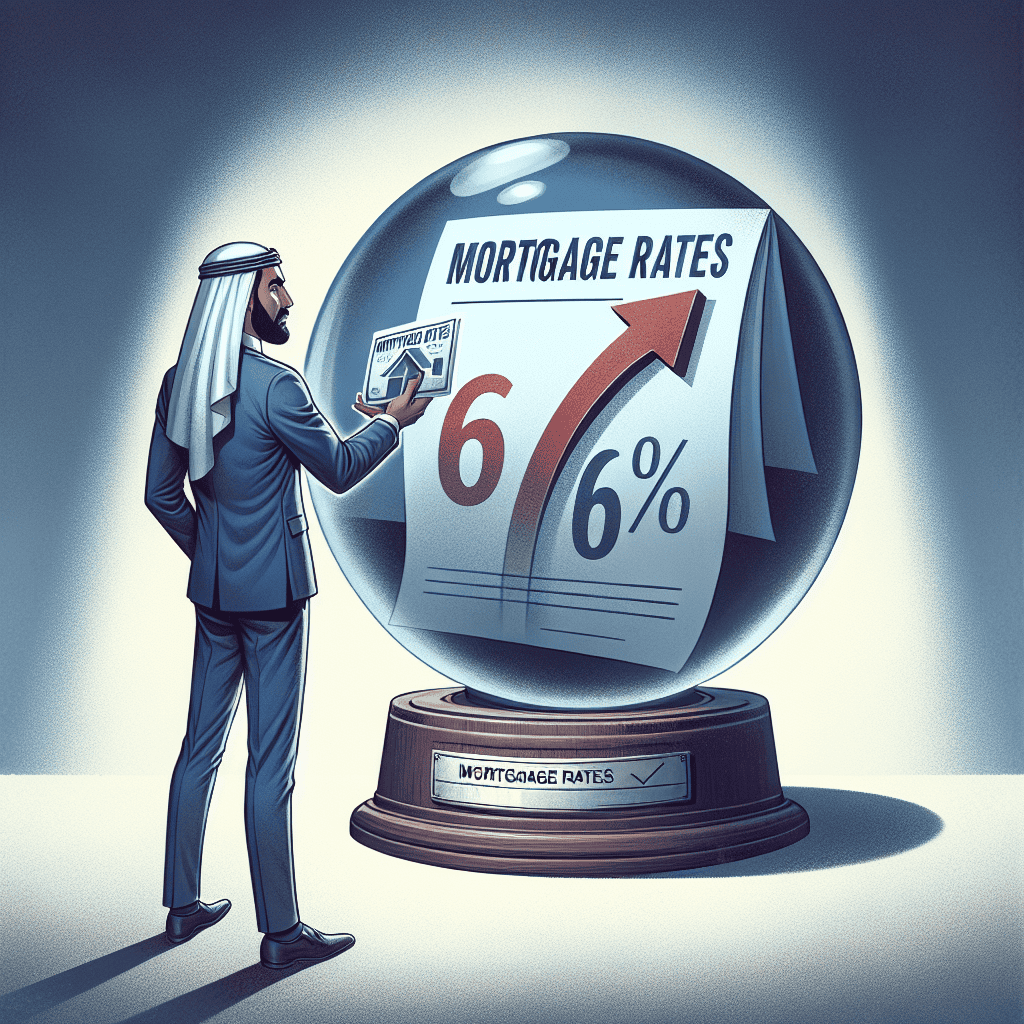“Lock in or Look Out: Navigating the New Normal of Mortgage Rates Above 6%!”
Introduction
Mortgage rates have remained a pivotal factor in the housing market, influencing both buyer affordability and overall market dynamics. As of late, these rates have consistently hovered above the 6% mark, marking a significant shift from the historically low rates seen in recent years. This trend is driven by a confluence of economic factors, including inflationary pressures, monetary policy adjustments by central banks, and broader financial market conditions. The persistence of mortgage rates above 6% is reshaping the landscape for prospective homebuyers and existing homeowners alike, prompting a reevaluation of financial strategies and long-term housing plans. As the market adapts to this new normal, stakeholders across the real estate spectrum are closely monitoring these developments, anticipating their impact on housing demand, pricing trends, and overall economic health.
Impact Of Sustained High Mortgage Rates On First-Time Homebuyers
The sustained elevation of mortgage rates above 6% has become a significant concern for first-time homebuyers, who are already navigating a complex and often challenging housing market. This persistent trend in mortgage rates is reshaping the landscape of homeownership, particularly for those entering the market for the first time. As these rates remain high, the financial burden on prospective buyers increases, making it more difficult for them to secure affordable housing options. Consequently, the dream of owning a home is becoming increasingly elusive for many.
To begin with, the direct impact of high mortgage rates is most evident in the increased cost of borrowing. For first-time homebuyers, who typically have less capital and fewer financial resources than repeat buyers, the higher interest rates translate into significantly larger monthly payments. This increase can strain budgets and limit the amount of money available for other essential expenses. Moreover, the elevated rates can reduce the overall purchasing power of these buyers, forcing them to settle for less desirable properties or locations. As a result, the quality of life and long-term satisfaction with their home purchase may be compromised.
In addition to the immediate financial implications, sustained high mortgage rates can also have broader economic effects that indirectly impact first-time homebuyers. For instance, as borrowing costs rise, the demand for homes may decrease, leading to a slowdown in the housing market. This deceleration can result in fewer new homes being built, which exacerbates the existing shortage of affordable housing. Consequently, first-time buyers face increased competition for a limited number of properties, driving up prices and further complicating their path to homeownership.
Furthermore, the psychological impact of high mortgage rates should not be underestimated. The prospect of taking on a substantial financial commitment in an uncertain economic environment can be daunting for first-time buyers. This apprehension may lead some individuals to delay their home purchase, opting instead to continue renting or living with family. While this decision may provide short-term financial relief, it can also have long-term consequences, such as missing out on the benefits of home equity accumulation and potential tax advantages associated with homeownership.
Despite these challenges, there are strategies that first-time homebuyers can employ to navigate the current market conditions. For example, prospective buyers can explore various mortgage products and programs designed to assist first-time buyers, such as those offering lower down payments or reduced interest rates. Additionally, working with a knowledgeable real estate agent or financial advisor can help buyers identify opportunities and make informed decisions. By staying informed and proactive, first-time homebuyers can better position themselves to overcome the obstacles posed by high mortgage rates.
In conclusion, the persistence of mortgage rates above 6% presents a formidable challenge for first-time homebuyers, affecting their financial capabilities, market opportunities, and overall confidence in pursuing homeownership. While the current environment is undoubtedly difficult, it is not insurmountable. By understanding the implications of these rates and exploring available resources, first-time buyers can still achieve their goal of owning a home. As the housing market continues to evolve, it remains crucial for these individuals to remain adaptable and informed, ensuring they are prepared to seize opportunities as they arise.
Strategies For Homeowners To Manage Higher Mortgage Payments
As mortgage rates continue to hover above 6% for the foreseeable future, homeowners are increasingly seeking strategies to manage the financial implications of higher mortgage payments. This trend, driven by a combination of economic factors and monetary policy adjustments, has prompted many to reassess their financial strategies to ensure long-term stability. Understanding the dynamics at play and exploring viable options can help homeowners navigate this challenging landscape effectively.
To begin with, it is essential for homeowners to conduct a thorough review of their current financial situation. This involves evaluating income streams, existing debts, and monthly expenses to gain a clear picture of their financial health. By doing so, homeowners can identify areas where adjustments can be made to accommodate higher mortgage payments. For instance, reducing discretionary spending or reallocating funds from non-essential categories can free up resources to cover increased housing costs.
In addition to budget adjustments, refinancing remains a potential option for some homeowners, albeit with certain caveats. While refinancing can offer lower monthly payments by extending the loan term, it is crucial to consider the associated costs and the long-term implications. Homeowners should carefully assess whether the benefits of refinancing outweigh the costs, particularly in a high-interest-rate environment. Consulting with a financial advisor can provide valuable insights and help determine if this strategy aligns with individual financial goals.
Moreover, exploring alternative income sources can be a proactive approach to managing higher mortgage payments. Homeowners might consider renting out a portion of their property, such as a basement or an accessory dwelling unit, to generate additional income. This not only helps offset mortgage costs but also maximizes the utility of the property. However, it is important to be aware of local regulations and zoning laws that may impact the feasibility of such arrangements.
Another strategy involves making extra payments towards the principal balance of the mortgage. By doing so, homeowners can reduce the overall interest paid over the life of the loan and potentially shorten the loan term. Even small, consistent additional payments can have a significant impact over time. This approach requires discipline and careful financial planning but can ultimately lead to substantial savings.
Furthermore, homeowners should remain informed about potential government programs or incentives designed to assist those facing financial difficulties due to rising mortgage rates. These programs may offer temporary relief or restructuring options that can ease the burden of higher payments. Staying updated on available resources and understanding eligibility criteria can provide a safety net during challenging times.
Lastly, maintaining open communication with lenders is crucial. If financial difficulties arise, reaching out to the lender early can lead to more favorable outcomes. Lenders may offer temporary forbearance or loan modification options to help homeowners manage their payments. Proactive communication demonstrates responsibility and a willingness to address financial challenges, which can be beneficial in negotiating terms.
In conclusion, while mortgage rates above 6% present challenges for homeowners, a combination of strategic financial planning, exploring alternative income sources, and staying informed about available resources can help manage higher mortgage payments effectively. By taking a proactive approach and leveraging available options, homeowners can navigate this period of elevated rates with greater confidence and financial resilience.
Long-Term Economic Implications Of Elevated Mortgage Rates
The persistence of mortgage rates above 6% has become a defining feature of the current economic landscape, with significant implications for both the housing market and the broader economy. As these elevated rates continue to shape financial decisions, it is crucial to understand the long-term economic implications that may arise from this trend. To begin with, the sustained high mortgage rates have a direct impact on housing affordability. Prospective homebuyers face increased monthly payments, which can deter many from entering the market. This, in turn, can lead to a slowdown in home sales, affecting real estate agents, mortgage lenders, and other related industries. As fewer homes are sold, the demand for new construction may also decline, potentially leading to a slowdown in the construction industry and affecting employment in this sector.
Moreover, the ripple effects of elevated mortgage rates extend beyond the housing market. As individuals allocate a larger portion of their income to mortgage payments, their disposable income for other goods and services diminishes. This reduction in consumer spending can have a dampening effect on economic growth, as consumer expenditure is a significant driver of the economy. Businesses may experience decreased sales, leading to potential cutbacks in production and employment. Consequently, the broader economy may face challenges in maintaining robust growth rates.
In addition to affecting consumer behavior, high mortgage rates can influence monetary policy decisions. Central banks, such as the Federal Reserve in the United States, may need to carefully consider the balance between controlling inflation and supporting economic growth. While higher interest rates can help curb inflationary pressures, they can also stifle economic activity if they remain elevated for an extended period. Policymakers must navigate this delicate balance to ensure that the economy remains on a stable growth trajectory.
Furthermore, the long-term implications of elevated mortgage rates may also include shifts in demographic trends. Younger generations, who are already burdened with student debt and other financial obligations, may find it increasingly difficult to enter the housing market. This could lead to a delay in homeownership, with potential consequences for family formation and wealth accumulation. As homeownership has traditionally been a key component of wealth building, prolonged high mortgage rates could exacerbate wealth inequality, as those who are unable to purchase homes miss out on the opportunity to build equity.
Additionally, the rental market may experience increased demand as potential homebuyers opt to rent instead. This shift could lead to rising rental prices, further straining household budgets and potentially leading to increased housing insecurity for lower-income individuals and families. As rental markets tighten, policymakers may need to consider interventions to ensure affordable housing options remain available.
In conclusion, the persistence of mortgage rates above 6% carries significant long-term economic implications. From affecting housing affordability and consumer spending to influencing monetary policy and demographic trends, the impact of elevated mortgage rates is far-reaching. As these rates continue to shape the economic landscape, it is essential for policymakers, businesses, and individuals to adapt to the changing environment and address the challenges that arise. By understanding and responding to these implications, stakeholders can work towards ensuring a stable and prosperous economic future.
Comparing Historical Mortgage Rate Trends And Current Market Conditions

Mortgage rates have long been a critical factor in the housing market, influencing both buyers’ decisions and the broader economic landscape. Historically, these rates have experienced significant fluctuations, shaped by a myriad of economic conditions and policy decisions. In recent times, mortgage rates have remained above 6%, a level that has prompted comparisons with historical trends and raised questions about the current market conditions.
To understand the implications of mortgage rates staying above 6%, it is essential to examine historical trends. In the early 1980s, mortgage rates soared to unprecedented levels, peaking at over 18% due to the Federal Reserve’s aggressive measures to combat inflation. This period was marked by high inflation and economic uncertainty, which necessitated stringent monetary policies. As inflation was brought under control, mortgage rates gradually declined, reaching more manageable levels in the subsequent decades. The 1990s and early 2000s saw rates stabilize, often hovering between 6% and 8%, which was considered relatively affordable at the time.
The financial crisis of 2008 marked another pivotal moment in the history of mortgage rates. In response to the economic downturn, central banks around the world, including the Federal Reserve, implemented policies to lower interest rates to stimulate economic activity. Consequently, mortgage rates fell to historic lows, often dipping below 4%. This period of low rates persisted for several years, making homeownership more accessible to a broader segment of the population and fueling a housing market boom.
However, the current market conditions present a different scenario. Several factors contribute to the persistence of mortgage rates above 6%. Firstly, the global economy is grappling with the aftermath of the COVID-19 pandemic, which has disrupted supply chains and led to inflationary pressures. Central banks, including the Federal Reserve, have responded by gradually increasing interest rates to curb inflation, which in turn has pushed mortgage rates higher.
Moreover, the geopolitical landscape has added another layer of complexity. Tensions in various regions, coupled with uncertainties surrounding trade policies, have created an environment of caution among investors. This has led to fluctuations in financial markets, further influencing mortgage rates. Additionally, the housing market itself has undergone significant changes. The demand for housing remains robust, driven by demographic shifts and changing preferences for living spaces. However, supply constraints, exacerbated by labor shortages and rising material costs, have contributed to elevated home prices, making affordability a pressing concern.
In light of these factors, it appears that mortgage rates may remain above 6% for the foreseeable future. This has implications for both prospective homebuyers and the broader economy. For buyers, higher rates mean increased borrowing costs, which could dampen demand and slow the pace of home sales. On the other hand, for the economy, sustained higher rates could signal a shift towards more normalized monetary policy, reflecting efforts to balance growth with inflation control.
In conclusion, while mortgage rates above 6% may seem daunting compared to the lows experienced in the past decade, they are not unprecedented when viewed through a historical lens. The current market conditions, shaped by a confluence of economic, geopolitical, and housing market factors, suggest that these rates may persist for some time. As such, stakeholders in the housing market must navigate this environment with a keen understanding of both historical trends and present-day realities.
How High Mortgage Rates Influence Real Estate Investment Decisions
The persistence of mortgage rates above 6% has become a significant factor influencing real estate investment decisions. As these elevated rates continue to shape the landscape, investors are compelled to reassess their strategies and adapt to the evolving market conditions. Understanding the implications of high mortgage rates is crucial for making informed investment choices.
To begin with, high mortgage rates directly impact the cost of borrowing, which is a critical consideration for real estate investors. When rates rise, the cost of financing a property increases, leading to higher monthly mortgage payments. This, in turn, affects the overall return on investment, as a larger portion of rental income or resale value must be allocated to cover financing costs. Consequently, investors may find it challenging to achieve the desired profit margins, prompting them to reconsider their investment portfolios.
Moreover, elevated mortgage rates can influence property valuations. As borrowing becomes more expensive, the pool of potential buyers may shrink, leading to reduced demand for real estate. This decrease in demand can exert downward pressure on property prices, potentially resulting in lower appreciation rates. Investors who rely on property appreciation as a key component of their investment strategy may need to adjust their expectations and explore alternative avenues for generating returns.
In addition to affecting property values, high mortgage rates can also alter the dynamics of rental markets. As potential homebuyers face increased borrowing costs, some may opt to remain in the rental market longer, boosting demand for rental properties. This shift can create opportunities for investors to capitalize on rising rental prices, thereby offsetting some of the challenges posed by higher financing costs. However, it is essential for investors to conduct thorough market research to identify areas with strong rental demand and ensure that rental income can sufficiently cover mortgage payments and other expenses.
Furthermore, the impact of high mortgage rates extends beyond individual investment decisions to influence broader market trends. For instance, developers may become more cautious about launching new projects, given the potential for reduced buyer interest and slower sales. This cautious approach can lead to a slowdown in new construction, affecting the supply side of the market. Investors must remain vigilant and consider how these shifts in supply and demand dynamics could affect their investment strategies.
Despite the challenges posed by high mortgage rates, opportunities still exist for astute investors. For example, those with substantial capital reserves may find themselves in a favorable position to negotiate better terms or explore alternative financing options. Additionally, investors who focus on value-add properties or distressed assets may uncover opportunities to enhance property value through renovations or strategic management, thereby achieving attractive returns even in a high-rate environment.
In conclusion, the sustained presence of mortgage rates above 6% necessitates a careful reevaluation of real estate investment strategies. Investors must consider the implications of higher borrowing costs, potential shifts in property valuations, and changes in rental market dynamics. By staying informed and adaptable, investors can navigate the challenges posed by elevated mortgage rates and identify opportunities that align with their financial goals. As the real estate market continues to evolve, a proactive and informed approach will be essential for making sound investment decisions in this high-rate environment.
The Role Of Government Policy In Addressing Rising Mortgage Rates
In recent years, the landscape of mortgage rates has undergone significant changes, with rates consistently staying above 6% for the foreseeable future. This shift has prompted a closer examination of the role government policy plays in addressing these rising mortgage rates. As mortgage rates are influenced by a myriad of factors, including economic conditions, inflation, and monetary policy, government intervention becomes a critical component in managing these rates to ensure housing affordability and economic stability.
To begin with, it is essential to understand the underlying causes of rising mortgage rates. One of the primary drivers is the central bank’s monetary policy, particularly the setting of interest rates. When central banks, such as the Federal Reserve in the United States, increase interest rates to combat inflation, mortgage rates tend to rise in tandem. This is because lenders adjust their rates to reflect the higher cost of borrowing money. Consequently, government policy aimed at controlling inflation indirectly impacts mortgage rates, making it a crucial factor in the broader economic equation.
Moreover, fiscal policy also plays a significant role in shaping mortgage rates. Government spending and taxation policies can influence economic growth and inflation, thereby affecting interest rates. For instance, expansive fiscal policies that lead to increased government spending can stimulate economic growth, potentially leading to higher inflation. In response, central banks may raise interest rates to curb inflationary pressures, which in turn can lead to higher mortgage rates. Therefore, a balanced approach to fiscal policy is necessary to maintain stable mortgage rates.
In addition to monetary and fiscal policies, government regulations in the housing and financial sectors can directly impact mortgage rates. Regulations that promote transparency and competition among lenders can help keep mortgage rates in check by preventing monopolistic practices and ensuring that consumers have access to a variety of lending options. Furthermore, government-backed mortgage programs, such as those offered by the Federal Housing Administration (FHA) or the Department of Veterans Affairs (VA), can provide more affordable mortgage options for certain segments of the population, thereby mitigating the impact of rising rates.
Another critical aspect of government policy in addressing rising mortgage rates is the implementation of measures to support housing affordability. As mortgage rates remain elevated, the cost of homeownership becomes increasingly burdensome for many individuals and families. Government initiatives aimed at increasing the supply of affordable housing, such as tax incentives for developers or subsidies for low-income homebuyers, can help alleviate some of the pressures caused by high mortgage rates. Additionally, policies that promote financial literacy and education can empower consumers to make informed decisions about their mortgage options, potentially leading to more favorable outcomes.
In conclusion, government policy plays a multifaceted role in addressing rising mortgage rates. Through a combination of monetary, fiscal, and regulatory measures, governments can influence the factors that drive mortgage rates and implement strategies to mitigate their impact on consumers. As mortgage rates remain above 6% for the foreseeable future, it is imperative for policymakers to adopt a comprehensive approach that balances economic growth, inflation control, and housing affordability. By doing so, they can help ensure that the dream of homeownership remains attainable for a broad spectrum of the population, even in the face of challenging economic conditions.
Tips For Refinancing Mortgages In A High-Rate Environment
In the current economic climate, mortgage rates have remained above 6% for an extended period, presenting challenges for homeowners considering refinancing. However, with careful planning and strategic decision-making, refinancing in a high-rate environment can still be beneficial. To navigate this landscape effectively, it is crucial to understand the factors influencing mortgage rates and explore strategies that can help mitigate the impact of higher rates.
Firstly, it is essential to recognize that mortgage rates are influenced by a variety of factors, including economic indicators, inflation, and monetary policy. As central banks adjust interest rates to manage economic growth and inflation, mortgage rates tend to follow suit. In a high-rate environment, these factors often converge to keep rates elevated, making it imperative for homeowners to stay informed about economic trends and forecasts. By understanding these dynamics, homeowners can better anticipate rate movements and make informed decisions about refinancing.
When considering refinancing, one of the primary objectives is to secure a lower interest rate than the existing mortgage. However, in a high-rate environment, achieving this goal may require a more nuanced approach. One strategy is to improve one’s credit score, as lenders typically offer more favorable rates to borrowers with strong credit profiles. By paying down existing debt, making timely payments, and correcting any inaccuracies on credit reports, homeowners can enhance their creditworthiness and potentially qualify for better refinancing terms.
Another approach is to explore different types of mortgage products. Adjustable-rate mortgages (ARMs), for instance, may offer lower initial rates compared to fixed-rate mortgages. While ARMs carry the risk of rate adjustments in the future, they can be advantageous for homeowners who plan to sell or refinance again before the rate adjustment period begins. Additionally, considering shorter loan terms, such as a 15-year mortgage instead of a 30-year one, can result in lower interest rates and significant interest savings over the life of the loan.
Moreover, it is important to evaluate the costs associated with refinancing. Closing costs, which can include appraisal fees, title insurance, and origination fees, can add up quickly. In a high-rate environment, these costs may outweigh the potential savings from a slightly lower interest rate. Therefore, homeowners should calculate the break-even point—the time it takes to recoup refinancing costs through monthly savings—and assess whether refinancing aligns with their long-term financial goals.
Furthermore, homeowners should consider the potential benefits of refinancing beyond just securing a lower rate. Refinancing can provide an opportunity to tap into home equity for renovations or debt consolidation, potentially improving overall financial health. Additionally, refinancing can allow homeowners to switch from an adjustable-rate mortgage to a fixed-rate one, providing stability and predictability in monthly payments.
In conclusion, while refinancing in a high-rate environment presents challenges, it is not without opportunities. By understanding the factors influencing mortgage rates, improving credit scores, exploring different mortgage products, and carefully evaluating costs, homeowners can make informed decisions that align with their financial objectives. As mortgage rates remain above 6% for the foreseeable future, adopting a strategic approach to refinancing can help homeowners navigate this landscape effectively and potentially achieve their financial goals.
Q&A
1. **Why are mortgage rates staying above 6%?**
Mortgage rates are influenced by various factors, including inflation, Federal Reserve policies, and economic conditions. Persistent inflation and the Fed’s efforts to control it by raising interest rates have contributed to mortgage rates remaining above 6%.
2. **How do high mortgage rates affect homebuyers?**
High mortgage rates increase the cost of borrowing, leading to higher monthly payments for homebuyers. This can reduce affordability and limit the purchasing power of potential buyers.
3. **What impact do elevated mortgage rates have on the housing market?**
Elevated mortgage rates can slow down the housing market by reducing demand, as fewer people can afford to buy homes. This can lead to a decrease in home sales and potentially stabilize or lower home prices.
4. **Are there any benefits to high mortgage rates?**
While high mortgage rates can be challenging for buyers, they can benefit savers and investors by offering higher returns on savings accounts and fixed-income investments.
5. **How long are mortgage rates expected to stay above 6%?**
The duration of mortgage rates staying above 6% depends on economic conditions, inflation trends, and Federal Reserve policies. Analysts suggest they may remain elevated until inflation is under control and the Fed adjusts its monetary policy.
6. **What strategies can homebuyers use in a high-rate environment?**
Homebuyers can consider strategies such as locking in rates early, exploring adjustable-rate mortgages, increasing down payments, or improving credit scores to secure better rates.
7. **How do high mortgage rates affect refinancing?**
High mortgage rates can deter homeowners from refinancing, as the potential savings from a lower rate may not justify the costs associated with refinancing. This can lead to a decrease in refinancing activity.
Conclusion
The persistence of mortgage rates above 6% for the foreseeable future can be attributed to several interrelated economic factors. Central banks, particularly the Federal Reserve, have been maintaining higher interest rates to combat inflation, which directly influences mortgage rates. Additionally, global economic uncertainties and supply chain disruptions continue to exert upward pressure on inflation, further justifying the central banks’ tight monetary policies. The housing market, already experiencing high demand and limited supply, is also contributing to sustained elevated rates. As a result, potential homebuyers may face affordability challenges, potentially cooling the housing market. In conclusion, unless there is a significant shift in monetary policy or a substantial improvement in economic conditions, mortgage rates are likely to remain above 6%, impacting both the housing market dynamics and consumer purchasing power.





